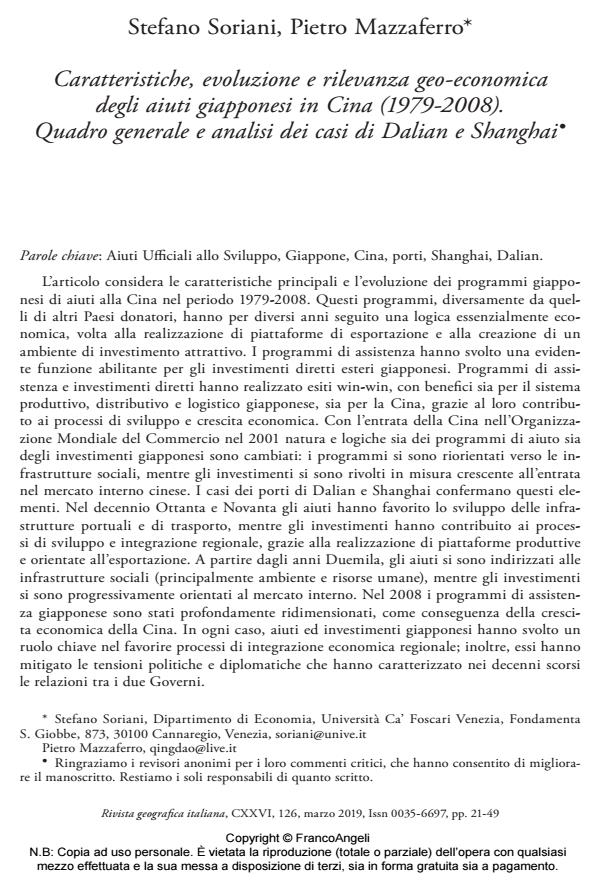Main characteristics, evolution and geo-economic importance of Japanese aid to China (1979-2008). General framework and analysis of Dalian and Shanghai cases
Journal title RIVISTA GEOGRAFICA ITALIANA
Author/s Stefano Soriani, Pietro Mazzaferro
Publishing Year 2019 Issue 2019/1
Language Italian Pages 29 P. 21-49 File size 201 KB
DOI 10.3280/RGI2019-001002
DOI is like a bar code for intellectual property: to have more infomation
click here
Below, you can see the article first page
If you want to buy this article in PDF format, you can do it, following the instructions to buy download credits

FrancoAngeli is member of Publishers International Linking Association, Inc (PILA), a not-for-profit association which run the CrossRef service enabling links to and from online scholarly content.
This article considers the main characteristics and the evolution of Japanese programs of Official Development Assistance (ODA) in China in the period 1979-2008. These programs strongly contributed to establish an attractive business environment for Japanese multinational firms. ODA programs played an evident enabling role for Japanese Foreign Direct Investments (FDI), particularly in the transport, distribution and logistics sectors, and in the automotive one. ODA programs and FDI have produced win-win outcomes, with benefits for both the Japanese industrial system, and for China, thanks to important contribution they gave to the economic development of many coastal regions. With the entry of China into the WTO in 2001, nature and logic of both ODA programs and FDI changed: ODA have been re-oriented mainly towards social infrastructures, while FDI have increasingly turned to exploit the potential of Chinese domestic market. The cases of the ports of Dalian and Shanghai confirm the above elements. In the 1980s and 1990s, aid favored the development of port and transport infrastructures, while FDI contributed to regional development and integration processes, thanks to the creation of manufacturing and export-oriented platforms. Since the 2000s, aid was directed towards social infrastructure (mainly environment and human resources), while investments started to focus more and more on the internal market. In 2008, ODA programs were profoundly downsized by the Japanese government, as a consequence of the changing role of China in the regional and global context. In any case, Japanese ODA programs and FDI played a key role in fostering regional economic integration processes; moreover, they have contributed to mitigate the political and diplomatic tensions that characterized China-Japan relations in past decades
Keywords: Official Development Assistance, Japan, China, ports, Shanghai, Dalian
- Changing Images? Italian Twitter Discourse on China and the United States during the First Wave of COVID-19 Frank Maracchione, Giulia Sciorati, Claudia Roberta Combei, in The International Spectator /2024 pp.77
DOI: 10.1080/03932729.2023.2299452
Stefano Soriani, Pietro Mazzaferro, Caratteristiche, evoluzione e rilevanza geo-economica degli aiuti giapponesi in Cina (1979-2008). Quadro generale e analisi dei casi di Dalian e Shanghai in "RIVISTA GEOGRAFICA ITALIANA" 1/2019, pp 21-49, DOI: 10.3280/RGI2019-001002